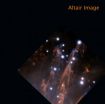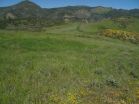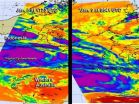(Press-News.org) PASADENA, Calif.—In an earthquake, ground motion is the result of waves emitted when the two sides of a fault move—or slip—rapidly past each other, with an average relative speed of about three feet per second. Not all fault segments move so quickly, however—some slip slowly, through a process called creep, and are considered to be "stable," or not capable of hosting rapid earthquake-producing slip. One common hypothesis suggests that such creeping fault behavior is persistent over time, with currently stable segments acting as barriers to fast-slipping, shake-producing earthquake ruptures. But a new study by researchers at the California Institute of Technology (Caltech) and the Japan Agency for Marine-Earth Science and Technology (JAMSTEC) shows that this might not be true.
"What we have found, based on laboratory data about rock behavior, is that such supposedly stable segments can behave differently when an earthquake rupture penetrates into them. Instead of arresting the rupture as expected, they can actually join in and hence make earthquakes much larger than anticipated," says Nadia Lapusta, professor of mechanical engineering and geophysics at Caltech and coauthor of the study, published January 9 in the journal Nature.
She and her coauthor, Hiroyuki Noda, a scientist at JAMSTEC and previously a postdoctoral scholar at Caltech, hypothesize that this is what occurred in the 2011 magnitude 9.0 Tohoku-Oki earthquake, which was unexpectedly large.
Fault slip, whether fast or slow, results from the interaction between the stresses acting on the fault and friction, or the fault's resistance to slip. Both the local stress and the resistance to slip depend on a number of factors such as the behavior of fluids permeating the rocks in the earth's crust. So, the research team formulated fault models that incorporate laboratory-based knowledge of complex friction laws and fluid behavior, and developed computational procedures that allow the scientists to numerically simulate how those model faults will behave under stress.
"The uniqueness of our approach is that we aim to reproduce the entire range of observed fault behaviors—earthquake nucleation, dynamic rupture, postseismic slip, interseismic deformation, patterns of large earthquakes—within the same physical model; other approaches typically focus only on some of these phenomena," says Lapusta.
In addition to reproducing a range of behaviors in one model, the team also assigned realistic fault properties to the model faults, based on previous laboratory experiments on rock materials from an actual fault zone—the site of the well-studied 1999 magnitude 7.6 Chi-Chi earthquake in Taiwan.
"In that experimental work, rock materials from boreholes cutting through two different parts of the fault were studied, and their properties were found to be conceptually different," says Lapusta. "One of them had so-called velocity-weakening friction properties, characteristic of earthquake-producing fault segments, and the other one had velocity-strengthening friction, the kind that tends to produce stable creeping behavior under tectonic loading. However, these 'stable' samples were found to be much more susceptible to dynamic weakening during rapid earthquake-type motions, due to shear heating."
Lapusta and Noda used their modeling techniques to explore the consequences of having two fault segments with such lab-determined fault-property combinations. They found that the ostensibly stable area would indeed occasionally creep, and often stop seismic events, but not always. From time to time, dynamic rupture would penetrate that area in just the right way to activate dynamic weakening, resulting in massive slip. They believe that this is what happened in the Chi-Chi earthquake; indeed, the quake's largest slip occurred in what was believed to be the "stable" zone.
"We find that the model qualitatively reproduces the behavior of the 2011 magnitude 9.0 Tohoku-Oki earthquake as well, with the largest slip occurring in a place that may have been creeping before the event," says Lapusta. "All of this suggests that the underlying physical model, although based on lab measurements from a different fault, may be qualitatively valid for the area of the great Tohoku-Oki earthquake, giving us a glimpse into the mechanics and physics of that extraordinary event."
If creeping segments can participate in large earthquakes, it would mean that much larger events than seismologists currently anticipate in many areas of the world are possible. That means, Lapusta says, that the seismic hazard in those areas may need to be reevaluated.
For example, a creeping segment separates the southern and northern parts of California's San Andreas Fault. Seismic hazard assessments assume that this segment would stop an earthquake from propagating from one region to the other, limiting the scope of a San Andreas quake. However, the team's findings imply that a much larger event may be possible than is now anticipated—one that might involve both the Los Angeles and San Francisco metropolitan areas.
"Lapusta and Noda's realistic earthquake fault models are critical to our understanding of earthquakes—knowledge that is essential to reducing the potential catastrophic consequences of seismic hazards," says Ares Rosakis, chair of Caltech's division of engineering and applied science. "This work beautifully illustrates the way that fundamental, interdisciplinary research in the mechanics of seismology at Caltech is having a positive impact on society."
Now that they've been proven to qualitatively reproduce the behavior of the Tohoku-Oki quake, the models may be useful for exploring future earthquake scenarios in a given region, "including extreme events," says Lapusta. Such realistic fault models, she adds, may also be used to study how earthquakes may be affected by additional factors such as man-made disturbances resulting from geothermal energy harvesting and CO2 sequestration. "We plan to further develop the modeling to incorporate realistic fault geometries of specific well-instrumented regions, like Southern California and Japan, to better understand their seismic hazard."
"Creeping fault segments can turn from stable to destructive due to dynamic weakening" appears in the January 9 issue of the journal Nature. Funding for this research was provided by the National Science Foundation; the Southern California Earthquake Center; the Gordon and Betty Moore Foundation; and the Ministry of Education, Culture, Sports, Science and Technology in Japan.
INFORMATION:
Written by Katie Neith
Faulty behavior
New earthquake fault models show that 'stable' zones may contribute to the generation of massive earthquakes
2013-01-10
ELSE PRESS RELEASES FROM THIS DATE:
Next-generation adaptive optics brings remarkable details to light in stellar nursery
2013-01-10
A new image released today reveals how Gemini Observatory's most advanced adaptive optics (AO) system will help astronomers study the universe with an unprecedented level of clarity and detail by removing distortions due to the Earth's atmosphere. The photo, featuring an area on the outskirts of the famous Orion Nebula, illustrates the instrument's significant advancements over previous-generation AO systems.
"The combination of a constellation of five laser guide stars with multiple deformable mirrors allows us to expand significantly on what has previously been possible ...
Microscopic blood in urine unreliable indicator of urinary tract cancer
2013-01-10
Rochester, MN, January 9, 2013 – Microscopic amounts of blood in urine have been considered a risk factor for urinary tract malignant tumors. However, only a small proportion of patients referred for investigation are subsequently found to have cancer. A new Kaiser Permanente Southern California study published in the February Mayo Clinic Proceedings reports on the development and testing of a Hematuria Risk Index to predict cancer risk. This could potentially lead to significant reductions in the number of unnecessary evaluations.
Individuals with microscopic hematuria ...
Small price differences can make options seem more similar, easing our buying decisions
2013-01-10
Some retailers, such as Apple's iTunes, are known for using uniform pricing in an effort to simplify consumers' choices and perhaps increase their tendency to make impulse purchases. But other stores, like supermarkets, often have small price differences across product flavors and brands.
As counterintuitive as it might seem, these small price differences may actually make the options seem more similar, according to new research published in Psychological Science, a journal of the Association for Psychological Science. The research shows that adding small differences ...
Online message boards provide outlets for mothers' concerns, MU researcher says
2013-01-10
COLUMBIA, Mo. –Parenting infants and toddlers can be challenging, and for generations, mothers have turned to other moms for advice. Now, with the availability of the Internet, mothers are consulting each other using modern venues: online message boards. Research from the University of Missouri indicates online discussion boards provide safe environments for mothers to anonymously express child-rearing concerns and receive support from other moms.
"Mothers have feelings that they might be embarrassed to talk about face-to-face with someone," said Jean Ispa, professor ...
Invading species can extinguish native plants despite recent reports
2013-01-10
TORONTO, ON – Ecologists at the University of Toronto and the Swiss Federal Institute of Technology Zurich (ETH Zurich) have found that, given time, invading exotic plants will likely eliminate native plants growing in the wild despite recent reports to the contrary.
A study published in Proceedings of the National Academy of Sciences (PNAS) reports that recent statements that invasive plants are not problematic are often based on incomplete information, with insufficient time having passed to observe the full effect of invasions on native biodiversity.
"The impacts ...
Engineering alternative fuel with cyanobacteria
2013-01-10
ALBUQUERQUE, N.M. — Sandia National Laboratories Truman Fellow Anne Ruffing has engineered two strains of cyanobacteria to produce free fatty acids, a precursor to liquid fuels, but she has also found that the process cuts the bacteria's production potential.
Micro-algal fuels might be one way to reduce the nation's dependence on foreign energy. Such fuels would be renewable since they are powered by sunlight. They also could reduce carbon dioxide emissions since they use photosynthesis, and they could create jobs in a new industry. President Barack Obama, speaking in ...
High fiber diet prevents prostate cancer progression
2013-01-10
A high-fiber diet may have the clinical potential to control the progression of prostate cancer in patients diagnosed in early stages of the disease.
The rate of prostate cancer occurrence in Asian cultures is similar to the rate in Western cultures, but in the West, prostate cancer tends to progress, whereas in Asian cultures it does not. Why? A University of Colorado Cancer Center study published in the January 2013 issue of the journal Cancer Prevention Research shows that the answer may be a high-fiber diet.
The study compared mice fed with of inositol hexaphosphate ...
Dark energy alternatives to Einstein are running out of room
2013-01-10
Research by University of Arizona astronomy professor Rodger Thompson finds that a popular alternative to Albert Einstein's theory for the acceleration of the expansion of the universe does not fit newly obtained data on a fundamental constant, the proton to electron mass ratio.
Thompson's findings, reported Jan. 9 at the American Astronomical Society meeting in Long Beach, Calif., impact our understanding of the universe and point to a new direction for the further study of its accelerating expansion.
To explain the acceleration of the expansion of the universe, astrophysicists ...
NASA sees Tropical Cyclone Narelle intensifying
2013-01-10
Infrared and near-infrared NASA satellite imagery provided signs to forecasters that Tropical Cyclone Narelle is intensifying as it moves southwest paralleling Western Australia coastline. Warnings have been posted as Narelle nears.
The Australian Bureau of Meteorology (ABM) issued the following watch and warnings for Narelle on Jan. 9: A cyclone watch is in effect for coastal areas from Whim Creek to Coral Bay. A Blue alert is in effect for coastal and island communities from Whim Creek to Mardie, including Wickham, Roebourne, Point Sampson, Karratha and Dampier.
The ...
Protective communities may reduce risk of drinking in teens
2013-01-10
UNIVERSITY PARK, Pa. -- Living in a caring community may help curb teenage alcohol use, while hanging out with antisocial peers can have the opposite effect, according to Penn State researchers studying substance abuse patterns.
The researchers evaluated how seven different categories of risk and protective factors predicted teen alcohol use. Risk factors included antisocial attitudes, antisocial behaviors, association with antisocial peers and family risk. Protective factors were positive community experiences, positive school experiences and family strengths.
Damon ...
LAST 30 PRESS RELEASES:
This new understanding of T cell receptors may improve cancer immunotherapies
A new fossil face sheds light on early migrations of ancient human ancestor
A new immunotherapy approach could work for many types of cancer
A new way to diagnose deadly lung infections and save lives
40 percent of MRI signals do not correspond to actual brain activity
How brain-inspired algorithms could drive down AI energy costs
Gum disease may be linked to plaque buildup in arteries, higher risk of major CVD events
Contrails are a major driver of aviation’s climate impact
Structure of dopamine-releasing neurons relates to the type of circuits they form for smell-processing
Reducing social isolation protects the brain in later life
Keeping the heart healthy increases longevity even after cancer
Young adults commonly mix cannabis with nicotine and tobacco
Comprehensive review illuminates tau protein's dual nature in brain health, disease, and emerging psychiatric connections
Book prepares K-12 leaders for the next public health crisis
Storms in the Southern Ocean mitigates global warming
Seals on the move: Research reveals key data for offshore development and international ecology
Sports injuries sustained during your period might be more severe
World's first successful 2 Tbit/s free-space optical communication using small optical terminals mountable on satellites and HAPS
Can intimate relationships affect your heart? New study says ‘yes’
Scalable and healable gradient textiles for multi‑scenario radiative cooling via bicomponent blow spinning
Research shows informed traders never let a good climate crisis go to waste
Intelligent XGBoost framework enhances asphalt pavement skid resistance assessment
Dual-function biomaterials for postoperative osteosarcoma: Tumor suppression and bone regeneration
New framework reveals where transport emissions concentrate in Singapore
NTP-enhanced lattice oxygen activation in Ce-Co catalysts for low-temperature soot combustion
Synergistic interface engineering in Cu-Zn-Ce catalysts for efficient CO2 hydrogenation to methanol
COVID-19 leaves a lasting mark on the human brain
Scientists use ultrasound to soften and treat cancer tumors without damaging healthy tissue
Community swimming program for Black youth boosts skills, sense of belonging, study finds
Specific depressive symptoms in midlife linked to increased dementia risk
[Press-News.org] Faulty behaviorNew earthquake fault models show that 'stable' zones may contribute to the generation of massive earthquakes




